The following text from Manfred Geissler was found as a typewritten manuscript in the estate. It was probably written for the exhibition “Zwischen oben als unten” (Between Above as Beneath) in the Tina Farina Gallery, Cologne, 1988. The passages highlighted by the author in quotation marks come from conversations with Lips. The editorial work was done by Angelika Wichert, Berlin.
Manfred Geissler
Why Pictures are Made or About the Origination of Pictures
Words are thoughts, coming close to something, stage props from pictures, just as pictures are stage props from complex, multi-dimensional systems, which are seemingly infinitive. Pictures manifest themselves under the influence of that which is within one:
and from that, which is external. There is the attraction of a person and/or an item, of a constellation of persons or items, which form a situation that may only last a fraction of a second, but can be photographically held firm as an image of the conditions of “existence.”
A picture is the permanent attempt to mirror the staggering between the polarities, the eternal return to the beginning, the cycle of birth-life-death, the in-between, the inner and outer, the emotion and the rational. Seeking clarity, definiteness, a stopping point “to find the inner path, the direction.” But the existence is unclear. Behind it is the question of where one came from, why and where one will go.
Roger Lips titles his exhibited works “Zwischen oben als unten” (Between Above as Beneath). The title comes from his analysis of Hermes Trismegistus and his World Rules. The principle can be explained like this: “Above as well as underneath: Everything that occurs on an upper level also finds its equivalent in a lower level …; everything in the world is bipolar …; between these … poles there rules a reciprocal flow of power. Everything runs in rhythmic cycles, and is subject to the law of balance and harmony.”
These principles are the basis for Roger Lips’ work. Roger Lips is concerned with the between the poles that is found in the field of tension. He wants to show that the relationships of the poles are reversible in both directions: above <-> bottom, positive <-> negative, inside <-> outside, etc.
The range of his artistic style of expression is diverse. One finds scenes which intuitively moved him, their workmanship as part drawing/part painting, the arrangement of selective enlargements up to abstraction, the complete destruction or new creation – the combination of projections one on top of another – of pictures and stage props, and the reversal of positive into negative. With the color photos, the color is actually never reproduced “real”: on the one hand almost monochrome-modulating colorfulness, on the other – through re-working and the use of different kinds of photo materials that bring about morbid color constellations, up to new (in part) guided artificial color combinations and screen appearances.
The main emphasis of this exhibition is the comparisons of two or more “Photo-Graphics” (graphic: Greek graphein for writing or to scratch; afterwards re-working by hand) that become new photo combinations that correspond with one another.
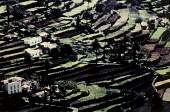 |
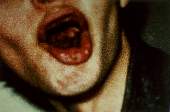 |
Without title, 1988 |
Without title, 1988 |
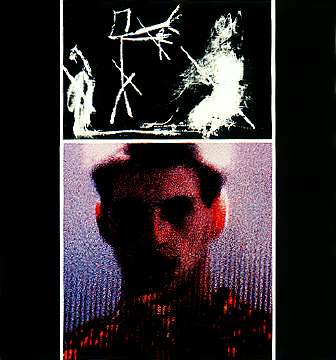 |
Without title, 1988 |
“New rhythm, harmony, disharmony …”: Sometimes they are a pair of pictures that are next to or on top of one another, sometimes reminiscent of the classic form of the triptych or also presented as a line-up of variations of the same picture.
With the first group of pictures portrayed here one sees an iconographic symbol-like drawing (“censured gestures”) set against a depersonalized portrait of “helplessness.” Both of the pictures are flanked by black portions which, if one refers back to the classic triptych function where the side-panel pictures allude to the middle picture, appear here simply as black boundaries and offer no differentiating reference other than just that: to be black, “imprisoned in darkness.”
In the second group of pictures a previously made picture is projected on the wall, whose surface is not the usual smooth one, but a rather uneven screen which finds itself in more of a stage of decay. The scenery has been photographically copied and is seen as an image of a projected image (time-space continuum). “… the projection of the inner picture of the viewer”: A person caught in the beam of light of the gestures of the person effected/singled out, “… heart gripping.” In the lower picture there is a reversal: A formerly white streak of light (from the positive print) is shown in the negative or in the re-reversal as a dark, snake-like form, which winds its way into an unclear constellation and is threatening.
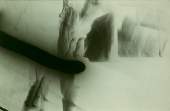 |
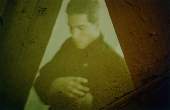 |
Without title, 1984/88 |
Without title, 1984/88 |
In the third group of pictures a landscape is shown, seeming at first to be far away but nevertheless with specific details greatly enlarged. It is thus grainy in the structure, almost pointillistic in style – a terraced landscape with parceled-out areas that are easily visible, “… a possible form of life.” The bottom picture shows the detailed section of a face, this time exaggeratedly enlarged so that only the mouth is in the center of the picture. Stretched wide open and in its distinctness it clearly illustrates a battle between great effort and resistance, possibly a bellow, a scream that hasn’t yet fully developed – a roar of liberation?!
We could say many things in a language whose words drift away like signals in imperceivable rooms that seem to be lost, as we attempted to form a picture of periods of time that we call the future, although it is our past. Ready not to recognize that which is known. The existence that appears to be taken for granted suddenly becomes a question “… the coincidence is part of the game -- is the possibility..."
Manfred Geissler, Cologne, July 1988